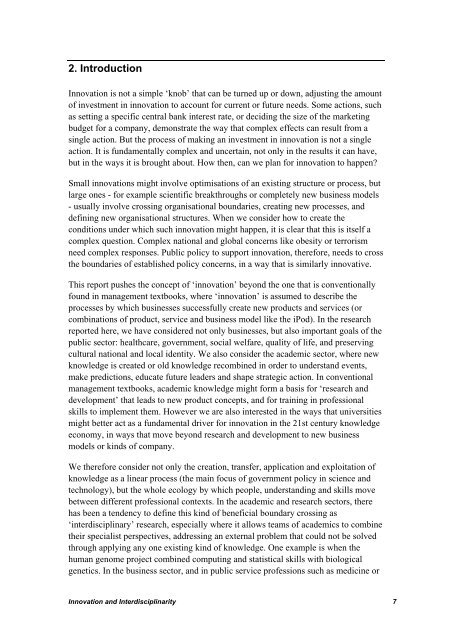Radical innovation: crossing knowledge boundaries with ...
Radical innovation: crossing knowledge boundaries with ...
Radical innovation: crossing knowledge boundaries with ...
Create successful ePaper yourself
Turn your PDF publications into a flip-book with our unique Google optimized e-Paper software.
2. Introduction<br />
Innovation is not a simple ‘knob’ that can be turned up or down, adjusting the amount<br />
of investment in <strong>innovation</strong> to account for current or future needs. Some actions, such<br />
as setting a specific central bank interest rate, or deciding the size of the marketing<br />
budget for a company, demonstrate the way that complex effects can result from a<br />
single action. But the process of making an investment in <strong>innovation</strong> is not a single<br />
action. It is fundamentally complex and uncertain, not only in the results it can have,<br />
but in the ways it is brought about. How then, can we plan for <strong>innovation</strong> to happen?<br />
Small <strong>innovation</strong>s might involve optimisations of an existing structure or process, but<br />
large ones - for example scientific breakthroughs or completely new business models<br />
- usually involve <strong>crossing</strong> organisational <strong>boundaries</strong>, creating new processes, and<br />
defining new organisational structures. When we consider how to create the<br />
conditions under which such <strong>innovation</strong> might happen, it is clear that this is itself a<br />
complex question. Complex national and global concerns like obesity or terrorism<br />
need complex responses. Public policy to support <strong>innovation</strong>, therefore, needs to cross<br />
the <strong>boundaries</strong> of established policy concerns, in a way that is similarly innovative.<br />
This report pushes the concept of ‘<strong>innovation</strong>’ beyond the one that is conventionally<br />
found in management textbooks, where ‘<strong>innovation</strong>’ is assumed to describe the<br />
processes by which businesses successfully create new products and services (or<br />
combinations of product, service and business model like the iPod). In the research<br />
reported here, we have considered not only businesses, but also important goals of the<br />
public sector: healthcare, government, social welfare, quality of life, and preserving<br />
cultural national and local identity. We also consider the academic sector, where new<br />
<strong>knowledge</strong> is created or old <strong>knowledge</strong> recombined in order to understand events,<br />
make predictions, educate future leaders and shape strategic action. In conventional<br />
management textbooks, academic <strong>knowledge</strong> might form a basis for ‘research and<br />
development’ that leads to new product concepts, and for training in professional<br />
skills to implement them. However we are also interested in the ways that universities<br />
might better act as a fundamental driver for <strong>innovation</strong> in the 21st century <strong>knowledge</strong><br />
economy, in ways that move beyond research and development to new business<br />
models or kinds of company.<br />
We therefore consider not only the creation, transfer, application and exploitation of<br />
<strong>knowledge</strong> as a linear process (the main focus of government policy in science and<br />
technology), but the whole ecology by which people, understanding and skills move<br />
between different professional contexts. In the academic and research sectors, there<br />
has been a tendency to define this kind of beneficial boundary <strong>crossing</strong> as<br />
‘interdisciplinary’ research, especially where it allows teams of academics to combine<br />
their specialist perspectives, addressing an external problem that could not be solved<br />
through applying any one existing kind of <strong>knowledge</strong>. One example is when the<br />
human genome project combined computing and statistical skills <strong>with</strong> biological<br />
genetics. In the business sector, and in public service professions such as medicine or<br />
Innovation and Interdisciplinarity 7

















